Property Editor: Scale Bar
Use the Scale Bar templates to add a Vertical (typically) or Horizontal scale bar to a report. When a vertical scale bar is added to a design sheet for the main body of a report, it can be used to navigate and paginate the report.
General
On the General tab, identify the template object and specify size, position, border and visibility options.
Identity
The Name attribute is used to identify the template in the Templates list. Template names must be unique. Choose a short but descriptive name which includes the template type and data category.
To avoid potential problems, avoid using spaces or special characters in template names.
Optionally enter a Description that describes what data is associated with the template object.
Size and Position
The template position is specified relative to the top left corner of the drawing area. The left co-ordinate (X) gives the offset from the left edge of the drawing area to the left edge of the template. The top co-ordinate (Y) gives the offset in millimetres from the top of the drawing area to the top of the template. These measurements do not include the page margins. Furthermore, scale bars have annotation margins which are also not included in the measurements. The co-ordinates of a scale bar refer to the top left corner of the bar itself.
Use the Width and Height properties of the object to adjust the size of the template object in the report. Keep the aspect ratio the same in order to prevent distortion of the image.
Border Style
Specify whether or not a rectangular border should be drawn around the template object. If you choose to draw a border, choose a single or double line style.
Visibility
Select the Hide this object option to hide the template object. The template will still be available for selection in the Templates list, but will not be visible in the report.
Annotation
On the Annotation tab, specify how annotated values (if any) will be displayed along the scale bar.
The horizontal or vertical scale of any scale bar is determined by the range of values defined for the scale bar. This in turn determines the scale of all templates that are associated with the scale bar.
In a typical graphic drillhole log, the depth range on the depth scale bar determines the vertical scale of most of the templates in the drawing. For example: assuming that the height of the depth scale bar is 200mm, a depth interval of 40 metres will result in a vertical scale of 1: 200.
For more information, refer to the Selecting a page or depth range topic.
Position and frequency
Specify the position and the frequency of annotations. A value of 1 indicates that every tick mark should be annotated; a value of 5 means that every fifth tick mark should be annotated.
Decimals
Specify how many (if any) decimal places are to be used by default when annotating values along the scale bar.
Optionally, select the Read from a field option and choose a dataset and a column, to read decimal precision values from a field. If field values are missing the default decimal precision will be used instead.

Tick mark interval

Specify a default tick interval (which must be greater than zero). Optionally, select the Read from a field option and choose a dataset and a column, to read tick interval values from a field. If field values are missing the default tick interval will be used instead.
Rescale logarithmic ticks
If a logarithmic scale is used the interval ticks may be drawn too close to each other. Select this option to ensure the annotation is legible.
Font characteristics
Select the font style, font size, and font Colour to be used for the annotation. You can also set the orientation of the text.

The characters in a vertical column are rotated 90 degrees anti-clockwise (up) or 270 degrees anti-clockwise (down). The characters in a stacked column are not rotated, but simply displayed vertically, as illustrated in the example below:
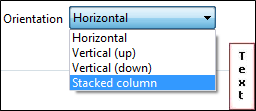
This option is enabled for Text labels, Field Labels, Date labels and Hyperlink labels.
Some printer drivers do not support the technique used to render the stacked text. Generally, colour printers will support the feature, while black and white printers will not. If your printer fails to display stacked text, try setting the raster graphics options for the printer and try again.
Colours
In the Colours tab, set the pen and brush colour and style options. A preview icon is displayed to the right of the colour, width, and style input boxes.
Pen Settings
The pen colour is the Colour used to draw the border and other lines making up the template. The pen style is the (solid, dot, dash etc.) line style and width used to draw the border and other lines making up the template.
Only solid lines are supported for line widths greater than 1.

Brush Settings
Set the brush (fill) Colour and style options. The brush colour is the colour used to render the background of the template. The fill style is the hatch or stipple used for the background.
You can fill the background using a standard brush, or you can base the symbology of the column on a Legend template.

While a graphic column uses a single column for the legend lookup, it is possible to base the symbology on a combination of fields (e.g. lithology type and descriptor) by concatenating these field values in a query. However, the legend would have to be set up accordingly, using a code list that caters for all possible code combinations.
Scaling
On the Scaling tab, select the type of scaling you require.

A Log10 scale is used on a horizontal scale bar in order to cater for a specific value distribution. When a Log10 scale is used for a line graph, individual nodes are plotted on the log10 scale and joined by straight lines.
If you select Proportional scaling, Graphic Reporter places items at regular intervals along the scale bar, using a proportional scale based on the total number of items to be displayed in relation to the width or height of the scale bar. This allows Graphic Reporter to generate point graphs, line graphs, bar graphs and graphic columns that are scaled proportionally, as shown in the following example.
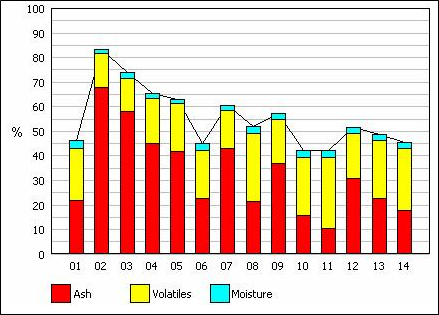
Start Value
Specify whether the start value (at the top or left of the scale bar) should be initialised using a fixed (constant) value, by linking to the end of another scale bar, or by reading the value from a field.
Automatically adjust the start value to
Optionally, specify how start values at the TOP/LEFT of the Vertical/Horizontal scalebar are to be adjusted in relation to the pagination. Start values can be adjusted to the nearest page increment, the nearest ticks increment, or not be adjusted at all.
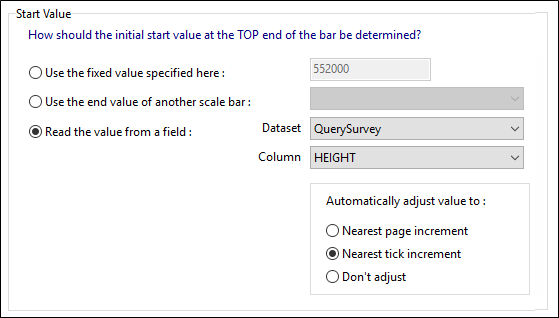
Scale bar range
The scale bar range is the value that will be added to the start value to calculate the end value. You can specify a constant (fixed) value for the range, or read the range from a field in a dataset.
If a negative value is entered, the start value will be greater than the end value. In this case, the scale bar is said to be inverted. (The start value is displayed at the bottom of the scale bar) When creating the X and Y axis for a scatterplot, for example, the Y axis could be represented using an inverted vertical scale bar.
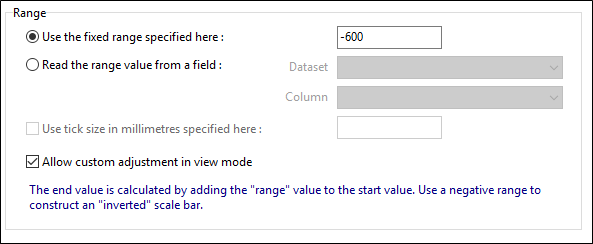
Tick increments and annotation intervals are not adjusted automatically.
Allow custom adjustment in view mode
By default, users may adjust the settings of a scale bar when a report is in view mode. To disallow customisation of the scale bar settings, deselect this option.
Paging
Select the Respond to paging events option if you want to increase the start value (by adding the Range increment specified above) whenever a paging event occurs.
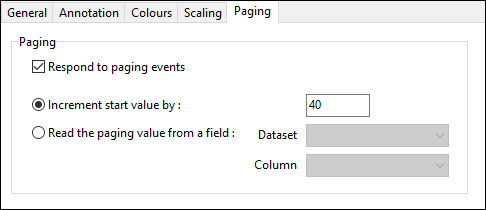
For more information about the options presented on the Scaling tab, see: Properties: Scale Bar.